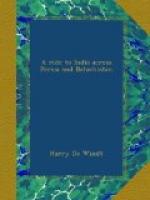The caves of Shahr-Rogan are not the only sights of interest near Beila. Time, unfortunately, would not admit of my visiting the mud-volcanoes of Las, situated near the Harra Mountains, about sixty miles from Shahr-Rogan. The hills upon which these are found are from three to four hundred feet high, and are conical in form, with flattened and discoloured tops and precipitous sides. At their bases are numerous fissures and cavities reaching far into their interior. Captain Hart, who visited these geysers some years ago, describes them as basins of liquid mud, about a hundred paces in diameter, in a continual state of eruption. These geysers, or “chandra-kupr,” as they are called by the Baluchis, are also found on parts of the Mekran coast. Colonel Ross, H.M.’s Resident at Bushire, is of opinion that these coast craters have communication with the sea, as the state of the tides has considerable influence on the movements of the mud. This theory is, perhaps, strengthened by the fact that by the coast natives the volcanoes are called “Darya-Chan,” or “Eyes of the Sea.”
On the way back from Shahr-Rogan to Beila a herd of antelope was seen. I may here mention that, with one exception, this was the only occasion upon which I came across big game of any kind throughout the journey, although, from all accounts, there is no lack of wild animals in Baluchistan. Bear and hyena are found in the southern districts, and the leopard, wolf, ibex, and tiger-cat exist in other parts of the country. The wild dog is also found in the northern and more mountainous regions. The latter hunt in packs of twenty and thirty, and will seize a bullock and kill him in a few minutes. On the other hand, vermin and venomous animals are not so common as in India. Dangerous snakes are rare, though we were much annoyed by scorpions and centipedes in the villages of the north, and a loathsome bug, the “mangar,” which infests the houses of Kelat.
Riding homewards, we stopped about a mile out of Beila to inspect the Djam’s garden, a large rambling piece of ground about fifty acres in extent, enclosed by high walls of solid masonry. Never was I more surprised than upon entering the lofty iron gates guarded by a sowar in neat white uniform. It seemed incredible that such fertility and abundance could exist in this dry, arid land. The cool fragrant gardens, with their shady grass walks, forest trees, and palms, springing up, as it were, out of the scorched, stony desert, reminded one of a bunch of sweet-smelling flowers in a fever ward, and the scent of rose, jasmine, and narcissus was apparent quite half a mile away. In the centre of the garden is a tamarind tree of enormous girth. It takes twelve men with joined hands to surround it. Half an hour was spent in this pleasant oasis, which was constructed by the late Djam, after infinite trouble and expense, by means of irrigation from the Purali river. There are also two deep wells of clear water in the grounds, which are never quite dry even in the hottest seasons.




